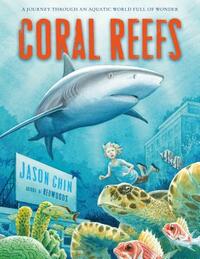You need to sign in or sign up before continuing.
Take a photo of a barcode or cover
Such a neat non-fiction book. The illustrations start with a girl in a library looking at a book and as she is reading the book the setting changes to the ocean so she becomes a part of what she is learning about. Great information about coral reefs, predator/prey, partnerships, animal adaptations, and other facts that kids will want to learn about.
Having dived on coral reefs around the Cayman Islands and being a librarian made this a near perfect book for me. I found it a wonderful combination of a story about the magic of reading, a library book that magically transports a girl underwater to a coral reef, and information - where she witnesses the inhabitants and relationships of these "aquatic cities:" food chains, schooling, adaptations, symbiosis, filter feeding... A page at the end discusses the "Threat to Coral Reefs" and how children can help. Another page discusses the remarkable relationship between coral and algae and gives some coral reef facts.
This is a beautiful book! It starts out with a little girl in a library who picks up a book about coral reefs. As she reads about them the library becomes the coral reef. Then at the end of the book when she's outside the library steps there are still remnants of the coral reef around her. Loved it!! It was similar to the style of Redwoods by the same author.
informative
fast-paced
I adored this book, and my students do too. It’s completely and utterly charming!
Thorough facts about the coral reefs with great illustrations.
What a talent!
This is the first Jason Chin book I have ever read. I would buy every single book he creates based on this book. The premise for this book is so clever. A girl goes to the New York Public Library to research her topic: coral reefs. She pulls this exact book of the shelf. The books also shown on the shelf are famous reads about the sea. Examples include, The Voyage of the Beagle, 20,000 Leagues Under the Sea, Endurance, The Odyssey, and Treasure Island. As the student walks by the shelf, she passes the books of importance to understanding the future: The Carbon Crisis, Fossil Fuels, and Rising Seas. As she delves into the book, the coral reefs themselves surround her and come alive.
I loved the reverence this book paid to the inquiry process, libraries, to New York Public Library in particular, the ability of a book to take you to worlds far away, and to teach you things one is unlikely to learn without them.
I did not know that coral reefs are the underwater cities of the ocean. I did not know that there are vast expanses of ocean where life doesn't thrive, hence. I didn't know that corals eat plankton, using their tentacles to catch the plankton so they can eat it. Heck, I didn't even know Belize had a coral reef!
This book is particularly superb at giving an overview of how a coral reef's real estate is laid out, from shoreline, to lagoon, to reef wall. It also excels at showing the complex relationships of animals that inhabit the reef and how they benefit from the coral. Surprisingly, naming and introducing the different types of coral isn't part of the book. This is more of a 'city-wide' overview of the coral reef and some of the individual animal inhabitants without a description and naming of the individual 'buildings' that exist on a coral reef.
Lastly, Jason Chin, shows each reader the concrete steps they can do to save coral reefs without waiting for anyone else. Even a landlubber far from a coral reef will finish this book knowing that they too can contribute to preserving this wonder.
Recommended for 4th grade-adult.
This is the first Jason Chin book I have ever read. I would buy every single book he creates based on this book. The premise for this book is so clever. A girl goes to the New York Public Library to research her topic: coral reefs. She pulls this exact book of the shelf. The books also shown on the shelf are famous reads about the sea. Examples include, The Voyage of the Beagle, 20,000 Leagues Under the Sea, Endurance, The Odyssey, and Treasure Island. As the student walks by the shelf, she passes the books of importance to understanding the future: The Carbon Crisis, Fossil Fuels, and Rising Seas. As she delves into the book, the coral reefs themselves surround her and come alive.
I loved the reverence this book paid to the inquiry process, libraries, to New York Public Library in particular, the ability of a book to take you to worlds far away, and to teach you things one is unlikely to learn without them.
I did not know that coral reefs are the underwater cities of the ocean. I did not know that there are vast expanses of ocean where life doesn't thrive, hence. I didn't know that corals eat plankton, using their tentacles to catch the plankton so they can eat it. Heck, I didn't even know Belize had a coral reef!
This book is particularly superb at giving an overview of how a coral reef's real estate is laid out, from shoreline, to lagoon, to reef wall. It also excels at showing the complex relationships of animals that inhabit the reef and how they benefit from the coral. Surprisingly, naming and introducing the different types of coral isn't part of the book. This is more of a 'city-wide' overview of the coral reef and some of the individual animal inhabitants without a description and naming of the individual 'buildings' that exist on a coral reef.
Lastly, Jason Chin, shows each reader the concrete steps they can do to save coral reefs without waiting for anyone else. Even a landlubber far from a coral reef will finish this book knowing that they too can contribute to preserving this wonder.
Recommended for 4th grade-adult.
This book was merely okay to me. I enjoyed the pictures very much but in terms of being and informative nonfiction work, it fell very flat. The writing is factual (as it should be) but was so overly dry. By reading the afterword, it was obvious that the author was passionate or at least interested but it did not capture me while I was reading the book. It is a great introductory piece for nonfiction but it simply left me wanting more and wishing for some passion in the subject.
I liked Redwoods better, but this was still good. And the writing was good and informative. But the art was so clever and engaging, it almost didn't need any words. And hey, I liked the self-referential bit of this book being in the book floating in the water with the girl at the library.
What I love about Jason Chin books is his ability to tell a story and facts at once. In this book he gives many facts about coral reefs - information about coral reefs, how they live, what lives near them, who uses them for survival. The information can be a little dry. But Jason Chin "jazzes" it up by having another story within his illustrations. There is a young girl reading this information from her book when all of a sudden she is swallowed up by the sea and now she sees the same information from her book.
Using the same style as his previous nonfiction book, REDWOODS, Jason Chin presents information about coral reefs. The strength of this book is in the beautiful illustrations - as the young protagonist gets more and more engrossed in a book about coral reefs, the reef appears all around her until she's swimming through the ocean, checking out all the animals. The large blocks of text may turn off browsing readers, though the book does include enough information for reports. While the format was innovative in REDWOODS, I'm suffering from some been-there-done-that syndrome with this title.




